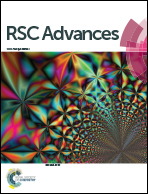Silk/agarose scaffolds with tunable properties via SDS assisted rapid gelation†
Abstract
Scaffolds with appropriate properties and a suitable shape based on the nature of the target tissue are essential in tissue engineering. In the present study, we developed a simple method to fabricate lyophilized silk/agarose scaffolds with tunable features (mechanical properties and pore structure) via controlling the gelation degree of silk fibroin and freeze-drying the gels with different gelation degrees. Sodium dodecyl sulfate (SDS) was utilized to control the gelling process of silk. Agarose helped retain the shape of the scaffolds after hydration and sterilization. Moreover, the scaffolds could be easily realized with the desired shape for specific applications by shaping the corresponding gels. The compressive modulus of the scaffolds was tunable within a range of 18.6–58.8 kPa, and inner pore sizes could be tuned from 52.3 ± 10.4 to 426.5 ± 138.5 μm. In vitro MC3T3-E1 cell proliferation indicated good biocompatibility of the silk/agarose scaffolds. Alkaline phosphatase (ALP) activity assay and mineralization analysis indicated that scaffolds with higher mechanical properties were more beneficial for osteogenic differentiation and mineralization. Thus, silk/agarose scaffolds are promising candidates for tissue engineering.



 Please wait while we load your content...
Please wait while we load your content...